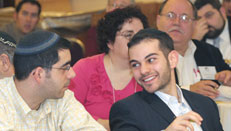 |
 Numbers have great symbolic value to people. Just look at the attachment athletes have to their jersey numbers. For Jews numbers are an important part of our tradition. One example is towards the end of the seder where we list the numerical symbols of one to thirteen. The number one, of course, is the symbol of the One G-d who controls the world, a message the Egyptians were slow to realize. Thirteen refers to the attributes of G-d which we must emulate as we strive to become better people. In between we have numbers symbolizing our founding fathers and mothers and our key books and mitzvoth. Yet one symbol seems out of place. "Who knows eleven? I know eleven. Eleven are the stars in Joseph's dream." Joseph's dream! Is that what we want mentioned at the seder? His dreams were the reason we ended up in Egypt in the first place. The young immature lad of 17 dreaming that his brothers will bow down to him elicited anger and jealousy from his older siblings not to mention rebuke from his father. These 11 stars caused us untold pain and suffering and mention of them appears out of place at the end of our most joyous meal.
Pesach is the time of communal unity, when the wise and the wicked can sit together at the same table, when disparate families come together as we realize despite all of our differences we are still one family. While the focus of Pesach is togetherness we must be constantly reminded to avoid the pitfalls of friction. In fact the seder reminds us of the dangers of internal strife in subtle but important ways. Our calendar is arranged so that Tisha B'av, the day of national mourning (caused by internal discord), always falls on the same day of the week as the first day of Pesach. It is customary to eat an egg, a food associated with mourning, to symbolize the festival sacrifice which we no longer have. Our seder begins with hah lachma anyah, this is the bread of affliction where we remind ourselves that we are still in exile. It ends with chad gadia symbolizing the persecutions we have endured throughout history where we have literally been eaten alive. Both passages, in contradistinction to the rest of the hagadah, are in Aramaic the language associated with the Babylonian exile. And of course both at the beginning and at the end of the seder we pray that next year we shall celebrate the seder in Jerusalem complete with a pascal lamb. The seder is a time for rejoicing but if we don't learn from the mistakes of Yosef and his brothers redemption will remain a dream.
There is also much on the positive side that we can learn from the subtle reminders of Joseph. "And Moses took the bones of Joseph with him for he had bound the children of Israel by oath saying G-d will surely remember you then carry up my bones with you" (Exodus 13:19). The Jews are about to depart Egypt and Moshe is worrying about the bones his of long deceased ancestor! Yet Moshe understood that the future of the Jewish people was dependent on maintaining a link with the past. It may have been the mistakes of Yosef that led to our sojourn in Egypt but it was his approach to life in exile that is to serve as the model for the Jewish people. His continued faith in G-d during trying times, his moral strength in rejecting the advances of his boss's wife, his constant use of the name of G-d and his fidelity to the traditions of his parents and grandparents despite the allure of the Egyptian way of life must serve as an inspiration to us. Perhaps most importantly for the fledging Jewish nation he had the ability to foresee crisis and to strategize effectively to meet the challenges that lie ahead.
Though the average slave had no idea who Joseph was, Moshe made sure that they would soon find out. His casket was to serve as a reminder of the importance of unity amongst the people and as a source of inspiration in coping with the inevitable challenges that lie ahead. In our haste to move forward we must be sure to maintain the link with our past. Chag Sameach!
|
 |








